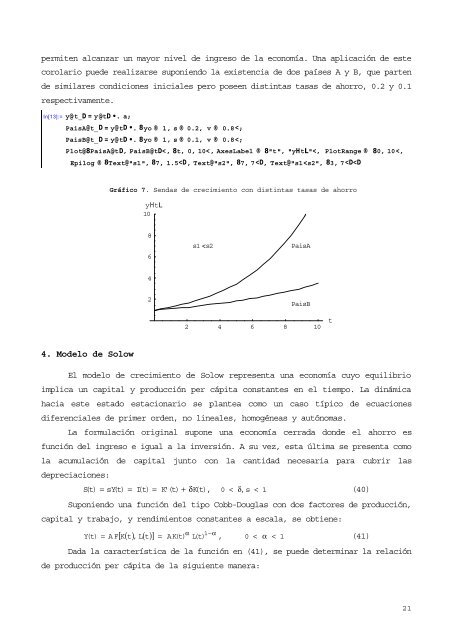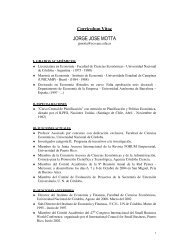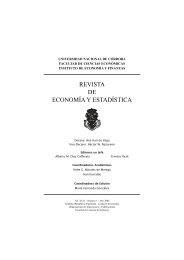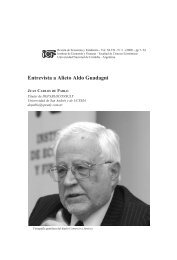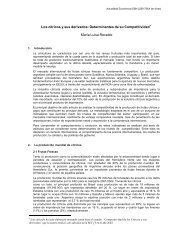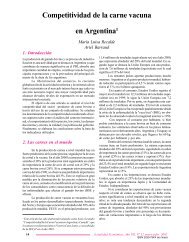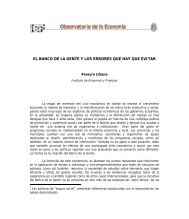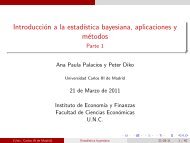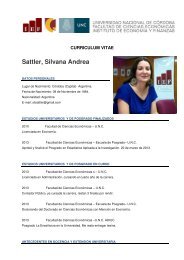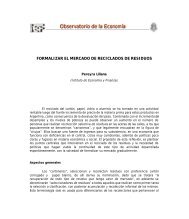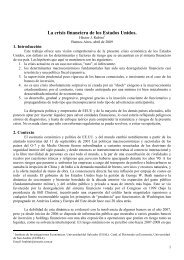Notas sobre ecuaciones diferenciales. Aplicaciones a la TeorÃa del ...
Notas sobre ecuaciones diferenciales. Aplicaciones a la TeorÃa del ...
Notas sobre ecuaciones diferenciales. Aplicaciones a la TeorÃa del ...
You also want an ePaper? Increase the reach of your titles
YUMPU automatically turns print PDFs into web optimized ePapers that Google loves.
Table 9. Cultural Values and the Role of Religion for Women’s Employment Decisions(1) (2) (3) (4) (5)Female LFP in Home Country 0.270** 0.280** 0.281** 0.456*** 0.447***(0.117) (0.116) (0.119) (0.147) (0.149)Muslim -0.241*** -0.187*** -0.087* -0.134** -0.056(0.042) (0.042) (0.048) (0.060) (0.054)Orthodox Christian 0.047 0.065 0.043 -0.055 -0.058(0.049) (0.042) (0.044) (0.053) (0.053)Buddhist -0.044 0.003 0.077 0.026 0.018(0.041) (0.050) (0.057) (0.070) (0.071)Hindu -0.101 -0.083 0.003 -0.034 -0.043(0.170) (0.157) (0.144) (0.114) (0.113)Partner: Muslim -0.095***(0.037)Full set of controls NO YES YES YES YESControls husband’s variables NO NO NO YES YESObservations 5254 5131 5131 2436 2436Pseudo R-squared 0.057 0.093 0.156 0.121 0.122Notes: The Table reports marginal effects of Probit estimates (evaluated at the mean values of the exp<strong>la</strong>natory variablesin the sample). Standard errors (corrected for heteroskedasticity and robust to clusters at the country of origin level) arereported in parentheses. The symbols ***, **, * indicate that coefficients are statistically significant, respectively, at the1, 5, and 10 percent level.7. Concluding RemarksCultural values seem to p<strong>la</strong>y a significant role in economic outcomes but, until recently, it has beenhard to prove empirically that culture causes economic behaviors. A recent promising empiricalstrategy is the epidemiological approach, re<strong>la</strong>ting immigrants’ behavior in the host country (within auniform economic and institutional environment) with economic or social patterns observed in theorigin country. However, the evidence gathered so far by the epidemiological approach is almostexclusively based on the US or Canadian immigrants.Following the epidemiological approach, in this paper we have investigated how culturalvalues from the home country affect work decisions of female immigrants in Italy, using the ISTATNational Survey of Households with Immigrants.Since Italy is a recent immigration country, we have used data on first generation immigrants.Although, from the one hand, this could lead to some estimation problems (due to <strong>la</strong>nguage barriersand other shocks hitting immigrants when they first move to a foreign country), on the other hand firstgeneration immigrants allow us to capture cultural influence that have occurred through a widervariety of channels (parents, schools, friends, neighbors, social groups, etc.) and that are less affectedby assimi<strong>la</strong>tion processes with the natives. A further advantage of using data on Italian immigrants isthat the <strong>la</strong>tter come from a <strong>la</strong>rge number of countries (118) and from all geographical areas, with verydifferent cultural background and religious beliefs.We re<strong>la</strong>te the probability of being employed in Italy for immigrant women with the female<strong>la</strong>bor force participation in the country of origin, taken as a proxy of cultural heritage and gender role20


